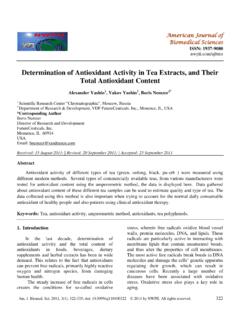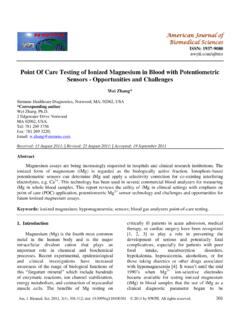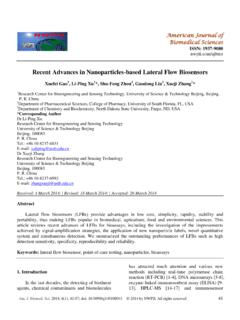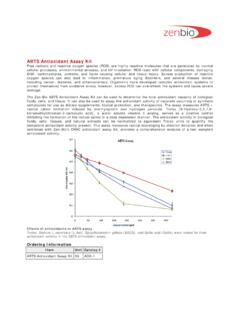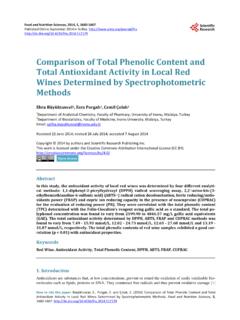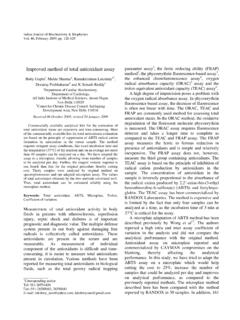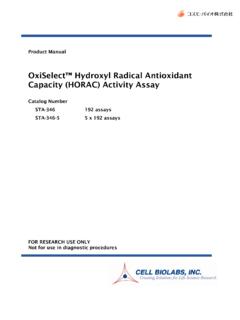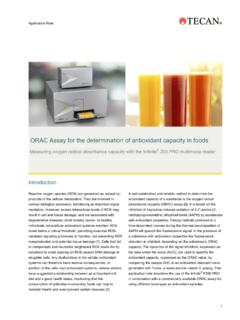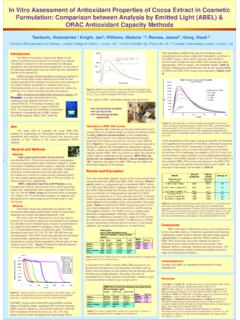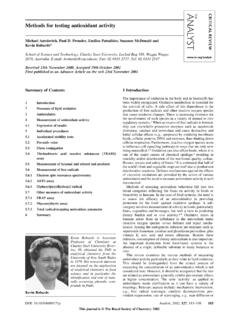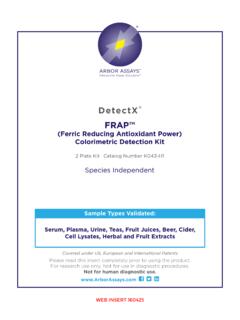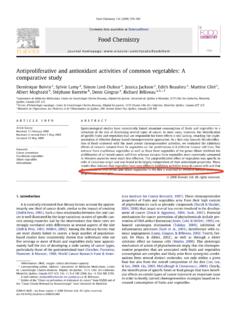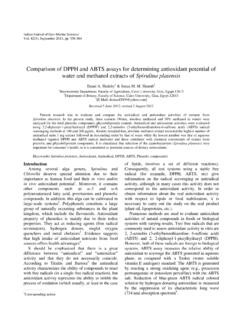Transcription of Diet Antioxidant Capacity: Relationships to Oxidative ...
1 American Journal of Biomedical Sciences ISSN: 1937-9080. diet Antioxidant capacity : Relationships to Oxidative Stress and Health Ronald L. Prior1* , Xianli Wu 2. 1. 214 Lakeshore Drive, Searcy, AR 72143, USA. 2. Hershey Center for Health and Nutrition, The Hershey Company, 1025 Reese Avenue, Hershey, PA 17033, USA. *. Corresponding author: Ronald L. Prior 214 Lakeshore Drive Searcy, AR 72143. USA. Email: Received: 30 January 2013; | Revised: 25 February 2013; | Accepted: 28 March 2013. Abstract This review will discuss some of the Antioxidant assays and biomarkers/measurements used to assess the effect of dietary components on ameliorating in vivo Oxidative stress. Although the development of dietary antioxidants has become a major component of the dietary supplement market, this review will focus on foods (primarily fruits and vegetables) and their impact on biomarkers of Oxidative stress and the ultimate appearance of disease states.
2 Data is reviewed demonstrating the importance of consumption of dietary antioxidants along with meals to prevent postprandial Oxidative stress. Epidemiology studies have demonstrated the Relationships between dietary Antioxidant intake in the form of polyphenolic type compounds and health outcomes. However, additional research is needed in order to clearly define the mechanism(s) of action of the polyphenolics and whether their effects are direct or indirect in nature. Keywords: Antioxidant , Oxidative stress, diet . Introduction species (ROS) are the primary reactive species in the human body. When the production of ROS. All animals need O2 for production of energy overwhelms Antioxidant defenses provided by in mitochondria [1]. When cells utilize oxygen to antioxidants and anti- Oxidative enzymes, a status generate energy, free radicals are created as a called Oxidative stress occurs.
3 Oxidative stress consequence of ATP (adenosine triphosphate) leads to cellular damage and may be a causative production by mitochondria. A free radical is any factor or lead to progression of chronic species containing an unpaired electron. With an degenerative diseases, such as cardiovascular unpaired electron in its atomic orbital, the free disease, cancer and Alzheimer's disease. Nutrient radical is highly reactive. There are many types antioxidants ( vitamin C, vitamin E, of free radicals and non-radical reactive species carotenoids, etc) have defined levels in the diet in living systems; nonetheless, reactive oxygen which are necessary to prevent specific Am. J. Biomed. Sci. 2013, 5(2), 126-139; doi: 2013 by NWPII. All rights reserved. 126. deficiencies leading to disease states. However, trapping Antioxidant parameter (TRAP), and there are another class of compounds found in crocin bleaching assays.
4 ET-based assays fruits and vegetables, commonly known as measure the capacity of an Antioxidant to prevent polyphenols, that show Antioxidant effects in the reduction of an oxidant, which changes color vitro, but whether they have any direct in vivo when reduced. The degree of color change is Antioxidant effects has been a topic of much correlated with the sample's Antioxidant debate, recently. In addition to possible direct concentrations. ET-based assays include: 1) the effects, dietary flavonoids may also have indirect total phenols assay by Folin-Ciocalteu reagent Antioxidant effects by stimulating in vivo (FCR), 2) Trolox equivalence Antioxidant Antioxidant systems which may prevent or relieve capacity (TEAC), 3) ferric ion reducing Oxidative stress. For instance, in biological Antioxidant power (FRAP), 4) "total Antioxidant systems glutathione (GSH) is a major potential" assay using a Cu(II) complex as an nonenzymatic Antioxidant involved in the oxidant, and 5) the diphenyl-1-picrylhydrazyl maintenance of redox balance which may (DPPH) assay .
5 The total phenols assay by FCR. ameliorate cellular Oxidative damage. At the has been used to quantify an Antioxidant 's cellular and molecular levels, redox imbalance reducing capacity and the ORAC assay to causes the activation of redox-sensitive quantify peroxyl radical scavenging capacity was transcription factors that lead to inflammation [2]. used to establish a dataset of Antioxidant capacity Thus, enhanced Oxidative stress due to of fruits and vegetables [6-9]. It has been a desire uncontrolled reactive oxygen species is a major by many to have a single conversion factor that factor in both acute and chronic inflammation and would relate different Antioxidant capacity inflammatory related diseases, including assays. However, this is not possible due to the atherosclerosis and diabetes. To assess the very different chemistries, different free radicals effectiveness of dietary antioxidants in vivo, involved and reaction mechanisms of the researchers have traditionally used a number of different assays with different Antioxidant markers of Oxidative stress and in the compounds.
6 Measurements of Antioxidant defense including Various Antioxidant capacity assays have Antioxidant enzymes such as superoxide been used to assess Antioxidant capacity of dismutases (SOD), glutathione peroxidases (GPx) biological samples such as plasma and tissues in and catalase (CAT) as well as molecules such a animal and human clinical studies. Among them, albumin, bilirubin and uric acid. ORAC is considered particularly biologically Measures of Antioxidant capacity have been relevant in that it uses the peroxyl radical, which developed to assess total antioxidants in fruits is the most common radical found in biological and vegetables and other dietary components and systems. Although the Antioxidant capacity to provide another biomarker of Oxidative stress assays can be useful for assessing Antioxidant in the form of plasma and tissue Antioxidant capacity of foods and also can be used for plasma capacity [3 4].
7 These Antioxidant capacity assays and tissues, it must be realized that these are in can be classified into two types based on their vitro test tube' assays and do not necessarily reactions with free radicals: assays based on take into account what happens to the dietary hydrogen atom transfer (HAT) reactions and antioxidants during absorption and metabolism. assays based on electron transfer (ET) [5]. The Thus, other in vivo biomarkers have been used to majority of HAT-based assays apply a assess in vivo Oxidative status and the competitive reaction scheme, in which effectiveness of dietary antioxidants . These Antioxidant and substrate compete for thermally biomarkers are usually the stable oxidized generated peroxyl radicals through the products of biological macromolecules. The most decomposition of azo compounds.
8 Assays of this commonly used biomarkers include carbonylated type include: 1) inhibition of induced low-density proteins, malondialdehyde and isoprostanes from lipoprotein autoxidation, 2) oxygen radical lipids and 8-hydroxy-2'-deoxyguanosine (8- absorbance capacity (ORAC), 3) total radical OHdG) from DNA. In addition, measurements of Am. J. Biomed. Sci. 2013, 5(2), 126-139; doi: 2013 by NWPII. All rights reserved. 127. Antioxidant defenses such as Antioxidant enzymes of subjects. All patients had definite diagnostic ( SOD, GPx and CAT) as well as non-enzyme categories (Poser criteria) for multiple sclerosis. antioxidants ( glutathione, vitamin E and The results showed that Oxidative stress plays an ubiquinol) are also widely used to evaluate the in important role in pathogenesis of multiple vivo redox status [10].
9 However, evaluation of sclerosis and suggests that dietary antioxidants any single biomarker/measurement or even a few may be important in the therapy of multiple may not truly reflect the overall in vivo sclerosis patients [15]. Antioxidant status. This may be one factor leading to seemingly differing conclusions from various antioxidants and Postprandial Oxidative Antioxidant research studies, because different Stress biomarkers were utilized. There is increasing evidence that Oxidative stress during the immediate postprandial state Oxidative Stress, antioxidants and Disease may be an important contributing factor to chronic diseases. Although, the results from the Excess ROS can damage cellular lipids, postprandial state in short term studies cannot proteins or DNA to impair their normal function.
10 Necessarily be extrapolated to long term disease Thus, Oxidative stress has been implicated in the development and outcome with certainty, such etiology of many chronic and degenerative studies can provide insight into dietary diseases, and it was also believed to play a major components that impact Oxidative stress and role in the aging process [11-13]. The Antioxidant status. The role of flavonoids and implication of Oxidative stress in the etiology of other phenolic compounds in protecting health chronic and degenerative diseases suggests that and lowering disease risk through their actions in antioxidants , both endogenously and mitigating fed-state metabolic and Oxidative exogenously, are necessary to protect cellular stressors is of interest. components from Oxidative damage. In early studies by Prior and coworkers [3], Oxidative stress and abnormalities in the changes in plasma Antioxidant capacity (AOC), as Oxidative defense system may occur in newborn determined using ORAC, following consumption infants.
